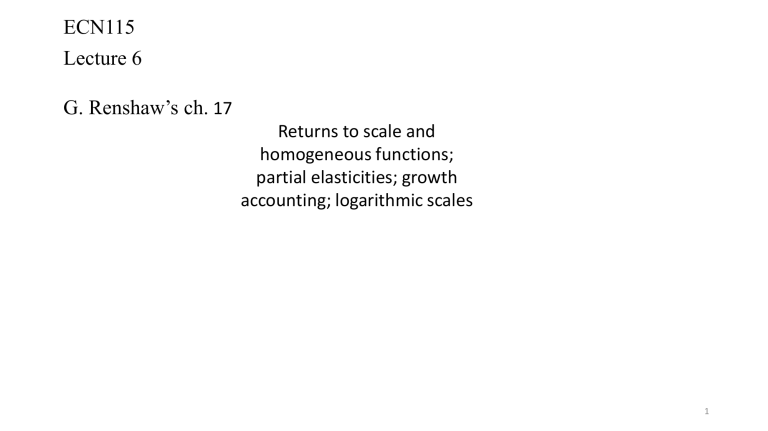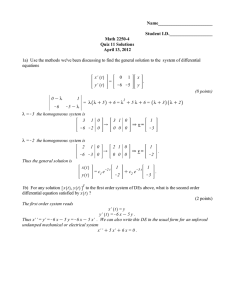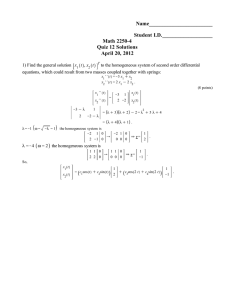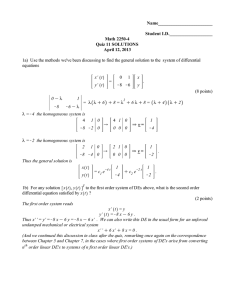
ECN115 Lecture 6 G. Renshaw’s ch. 17 Returns to scale and homogeneous functions; partial elasticities; growth accounting; logarithmic scales 1 Returns to scale Assuming that both 𝐾 and 𝐿 inputs double production will be moved to point 𝑁 where the output level is now 𝑄1 . The crucial question is the relationship between the new level of output (𝑄1 ) and the initial level (𝑄0 ). There are three possibilities: (1) If 𝑄1 = 2𝑄0 , then output has exactly doubled. Thus output has increased in the same proportion as the increase in inputs. This is the case of constant returns to scale. (2) If 𝑄1 > 2𝑄0 , then output has more than doubled. Thus output has increased in a greater proportion than the increase in inputs. This is the case of increasing returns to scale (also known as economies of scale). (3) If 𝑄1 < 2𝑄0 , then output has less than doubled. Thus output has increased in a smaller proportion than the increase in inputs. This is the case of decreasing returns to scale (also known as diseconomies of scale). Returns to scale are variable, depending on the initial position, but also possibly on the value of 𝜆. This is because the isoquants in the figure to the left have very different shapes from each other. Another possibility is that there are constant returns to scale when output is small (the initial position, J, is close to the origin) but strongly increasing returns to scale when output is large (J is far from the origin). 2 Returns to scale and homogeneity of 𝑄 = 𝑓 𝐾, 𝐿 when 𝜆 = 2 (doubling 𝐾 & 𝐿) Effect on Q when K and L are both doubled (from any initial position) Economist’s view (assuming Q = f(K, L) is a production function) Mathematician’s view (assuming Q = f(K, L) is a any function) Q is exactly doubled Function has uniform constant returns to scale Function has uniform increasing returns to scale Function has uniform decreasing returns to scale Function is homogeneous of degree 1 Function is homogeneous of degree greater than 1 Function is homogeneous of degree less than 1 Q is more than doubled Q is less than doubled Testing for homogeneity The procedure for testing for homogeneity is as follows. Given any function 𝑧 = 𝑓(𝑥, 𝑦): Step 1. We suppose that we are initially at some point 𝐽 of a plain, where 𝑥 = 𝑥0 , 𝑦 = 𝑦0 and consequently the value of 𝑧 is given by 𝑧0 = 𝑓(𝑥0 , 𝑦0 ) Step 2. We increase x and y by the factor 𝜆 their new values are therefore 𝑥1 = 𝜆𝑥0 and 𝑦1 = 𝜆𝑦0 . The new value the value of 𝑧 is given by 𝑧1 = 𝑓 𝑥1 , 𝑦1 = 𝑓(𝜆𝑥0 , 𝜆𝑦0 ) Step 3. If we can show from the equation 𝑧1 = 𝑓 𝜆𝑥0 , 𝜆𝑦0 that 𝑧1 = 𝜆𝑟 𝑧0 , then the function is said to be homogeneous of degree 𝑟. If we cannot, the function is not homogeneous 3 Properties of homogeneous functions Property 1: the 'parallel tangents' property 4 Properties of homogeneous functions Property 1: the 'parallel tangents' property RULE 17.1 The relationship between returns to scale and long-run average and marginal cost, given constant input prices If the production function is homogeneous of degree 1 (uniform constant returns to scale), then average cost is the same at every level of output. The average cost curve, as a function of output, is therefore a horizontal straight line. Consequently 𝑀𝐶 = 𝐴𝐶 = 𝑎 constant, at every output level (like the top right figure in the previous slide). If the production function is homogeneous of degree less than 1 (uniform decreasing returns to scale), average cost increases with output. The average cost curve is positively sloped, and marginal cost must be greater than average cost at any output (like the bottom left figure in the previous slide). If the production function is homogeneous of degree greater than 1 (uniform increasing returns to scale), average cost decreases with output. The average cost curve is negatively sloped, and marginal cost must be less than average cost at any output (like the bottom right figure in the previous slide). 5 Properties of homogeneous functions Property 2: the relationship between marginal and average products 6 Properties of homogeneous functions Property 2: the relationship between marginal and average products 7 Properties of homogeneous functions Property 3: Euler's theorem and the adding-up problem 8 Partial elasticities for any function 𝑦 = 𝑓(𝑥) arc elasticity is the difference quotient point elasticity is the derivative of the function both elasticities measure the rate of proportionate change of y. This contrasts with the difference quotient and the derivative , both of which measure the rate of absolute change. The difference between the two elasticity concepts is that the arc elasticity measures the average rate of proportionate change following a discrete change in x, while the point elasticity measures the rate of proportionate change at a point on the function. These concepts are easily extended to a function with two or more independent variables z = 𝒇(𝒙, 𝒚) arc partial elasticity of z with respect to x point partial elasticity of z with respect to x Partial elasticities of demand Suppose there are two goods, 𝑎 and 𝑏, and 𝑌 = consumers’ income. Let 𝑞𝑎 denote the total quantity of good a demanded by all consumers, and 𝑝𝑎 and 𝑝𝑏 denote the prices of goods 𝑎 and 𝑏. Then the combined demands of all consumers, known as the market demand function for good 𝑎, might be of the form 𝑞𝑎 = 𝑓(𝑝𝑎, 𝑝𝑏, 𝑌) The proportionate differential of a function total differential of a function 𝑧 = 𝑓(𝑥, 𝑦) is given by (17.3) ‘If there occurs a small proportionate change in 𝑥, and at the same time a small proportionate change in 𝑦, what is the resulting proportionate change in 𝑧?’ The proportionate differential of a function 𝑑𝑧 On the left-hand side we have , the proportionate change in 𝑧. 𝑧 On the right-hand side, the terms in brackets are the partial elasticities of the function. 𝑑𝑥 The partial elasticity with respect to 𝑥 is multiplied by , the proportionate change in 𝑥. 𝑥 Similarly, the partial elasticity with respect to 𝑦 is multiplied by 𝑑𝑦 , 𝑦 the proportionate change in 𝑦 So, in words, rule 17.3 is answering our question above as follows: 𝑑𝑧 ‘The resulting proportionate change in 𝑧, , is given by the sum of the proportionate changes in 𝑥 and 𝑦, each 𝑧 multiplied by its partial elasticity.’ In effect, the partial elasticities act as weights on the proportionate changes in 𝑥 and 𝑦. 𝑥 𝑑𝑧 If for example is large, then this acts as a heavy weight on so that the latter has a large effect on 𝑧. 𝑧 𝑑𝑥 Growth accounting In analysing the growth of total output in an economy over time, the standard neoclassical approach is to assume that there exists an aggregate production function for the whole economy of the form 𝑄 = 𝐹(𝐾, 𝐿), where 𝑄 = total output of goods and services (GDP) and 𝐾 and 𝐿 are the total inputs of capital and labour. the proportionate differential formula (rule 17.3) to this aggregate production function gives if we then expected the supply of capital to grow (due to investment) by, say, 20% over the next 10 years, and the supply of labour to grow by, say, 10% over the same period, then we get assume that the aggregate production function is of Cobb–Douglas form with constant returns to scale: that is then we know from rule 17.4 that the partial elasticities are Growth accounting then we know from rule 17.4 that the partial elasticities are One way of estimating 𝛼 is to use the marginal productivity conditions (see ch.16, lecture 03.7). The marginal productivity conditions state that with perfect competition and profit maximization, we will have If we substitute the marginal productivity conditions into the Partial elasticities, the partial elasticities become (17.7) Here 𝐾 × 𝑟 is the income received by owners of capital and 𝑄 × 𝑝 is aggregate income (GDP), 𝐾𝑟 So is the share of aggregate income received by owners of capital, which we can measure 𝑄𝑝 by looking at the share of profits in GDP. Similarly 𝐿 × 𝑤 is wage income, so is the share of wage income in GDP. (These are known as factor shares because 𝐿 and 𝐾 are the factors of production.) i. then equation (17.7) tells us that we can use the shares of profits and wages in GDP as estimates of the partial elasticities 𝛼 and 1 − 𝛼 respectively. ii. the methodology gives us a tool for explaining past growth of output by reference to the past growth of inputs. iii. the methodology helps also to predict the effects of an increase or decrease in the growth rate of inputs Logs, logs, logs Given any function, if we transform the function by taking natural logs, and then find the differential of the resulting function, this is equivalent to finding the proportionate differential of the original function. If you are struggling to grasp all of these results involving logs, hold tight to the basic fact 𝑑𝑦 that dln 𝑦 = for any variable 𝑦, provided 𝑑𝑦 is sufficiently small. 𝑦 In other words, for small changes, the absolute change in the log of a variable equals the proportionate change in the variable itself. Elasticity and logs In ch. 13, lecture 05 we have seen that any function 𝑦 = 𝑓(𝑥) Proportionate & absolute 17 Partial elasticities and logarithmic scales The proportionate differential and logs Recall from rule 17.3 above that the proportionate differential of the function 𝑧 = 𝑓(𝑥, 𝑦) is This formula, derived from the total differential, gives the proportionate differential (that is, as a function of the proportionate changes in 𝑥 and 𝑦, ( 𝑑𝑥 𝑥 and 𝑑𝑦 𝑦 𝑑𝑧 𝑧 ) ), and the partial elasticities. It is used frequently in economics because we are often focusing on proportionate rather than absolute changes. In lecture 05, ch.13 we mentioned that if 𝑦 is any variable that increases by a small Δ𝑦 amount, Δ𝑦, then approximately equals Δ(ln 𝑦). That is, the proportionate change in 𝑦 is 𝑦 approximately equal to the absolute change in the natural log of 𝑦. We can write this relationship as The proportionate differential and logs Rule 17.7 is true of any variable that changes for whatever reason. Therefore for variables 𝑧, 𝑥, and 𝑦 we have Log linearity with several variables Any function of the Cobb–Douglas form 𝑧 = 𝑥 𝛼 𝑦 𝛽 , where 𝛼 and 𝛽 are constants, has this property. This log linear property continues to hold as the number of independent variables increases: for example,𝑧 = 𝑥 𝛼 𝑦 𝛽 𝜈 𝛿 . (Of course, most functions are not log linear. The assumption that some functional relationship is log linear is merely a convenient simplification widely used in economics.) This is a log linear function in three dimensions. If we constructed its three-dimensional graph, with ln𝑄, ln𝐾, and ln𝐿 on the axes, the resulting surface would be a plane, with an intercept of ln𝐴 on the ln𝑄-axis and slopes in the ln𝐾 and ln𝐿 directions of 𝛼 and 𝛽 respectively. Study: from G. Renshaw’s ch. 17 Attempt: all relevant progress exercises for next week’s class/seminar prepare the so-called tutorial exercises for next week’s teamwork prepare & upload the so-called project exercises 22



